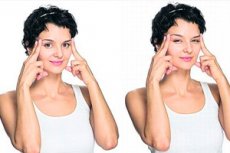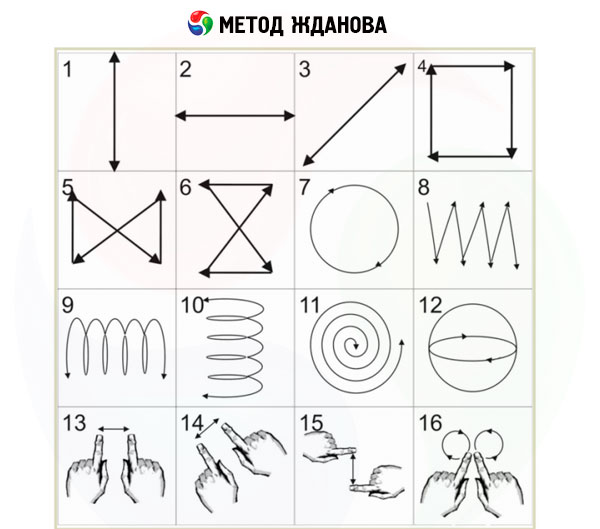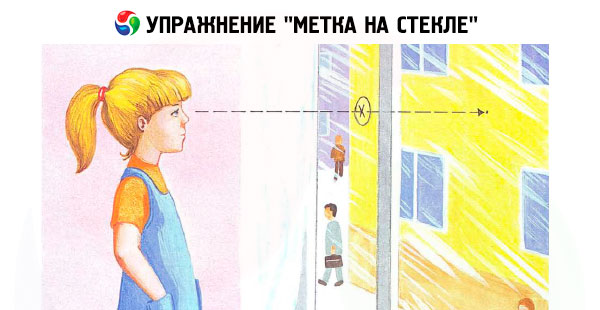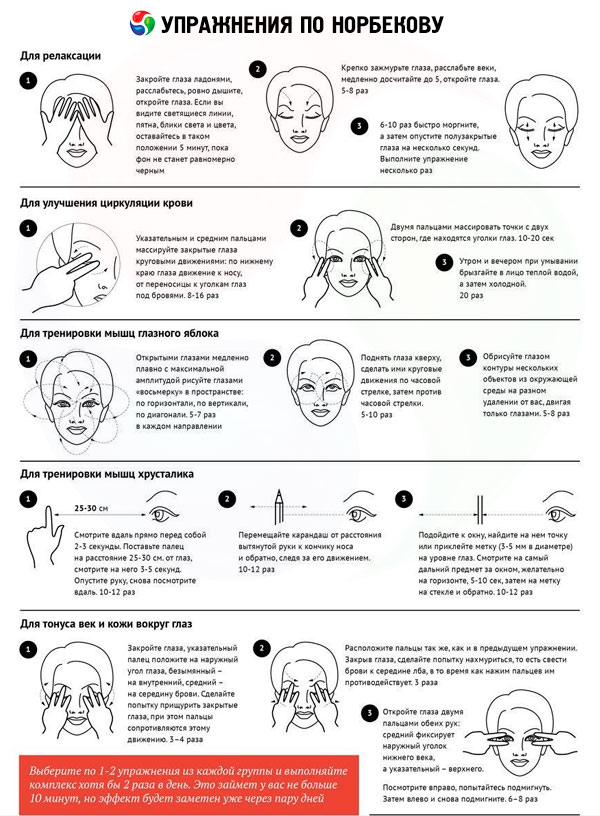Exercises to improve vision with myopia
Last reviewed: 23.04.2024

All iLive content is medically reviewed or fact checked to ensure as much factual accuracy as possible.
We have strict sourcing guidelines and only link to reputable media sites, academic research institutions and, whenever possible, medically peer reviewed studies. Note that the numbers in parentheses ([1], [2], etc.) are clickable links to these studies.
If you feel that any of our content is inaccurate, out-of-date, or otherwise questionable, please select it and press Ctrl + Enter.

A refractive anomaly that does not allow to see objects that are far away is called myopia or nearsightedness - a visual pathology, when the image received by the organ of vision does not reach the retina, but is located in front of it, which deprives it of clarity. To get a clear image, you need to return it to the retina. This is achieved in many ways: wearing glasses and contact lenses, in an operative way, with the same purpose, exercises were developed to improve vision with myopia. The effectiveness of training the eye muscles to return visual acuity people noticed a very long time, when the glasses had not been invented yet. Of course, correcting the eyesight with the help of lenses or glasses is much easier, visual gymnastics requires the application of certain efforts. However, myopia usually progresses. And, to avoid this, exercises with myopia are simply necessary. They do not exclude the wearing of glasses or contact lenses and are fully compatible with various conservative methods of vision correction. With the help of a complex of exercises, you can undoubtedly slow down the development of the disease, and sometimes improve your eyesight, as their daily performance contributes to the training of the eye muscles, in particular - ciliary, responsible for accommodation, improves blood flow in the choroid and strengthens the connective tissue of the eyeball - sclera.
Exercises for nearsightedness for children in principle do not differ from gymnastics for adults, it is simple from the proposed complexes to choose exercises that are easier for the child to repeat for you and remember, to reduce the number of repetitions. Children's gymnastics for the eyes are done no more than seven to eight minutes. For vision, any motor activity is useful - the child needs to walk more in the open air, jump, run, spend less time at the TV and computer monitor. When a child draws or writes while sitting at a table, it is necessary to watch his posture, to teach him to keep his back straight. An incorrect position at the table will become a habit and cause irreparable harm to the health of the child, including vision.
In adolescence, when the body is reconstructed, the hormonal background changes, the visual load increases: the child begins to read more, the school assignments take a much longer time, in addition, modern children look for information they are interested in on the Internet, leisure is also spent at the monitor, playing in the games, reading e-books, communicating in social networks, and myopia often progresses. Exercises for treating myopia in adolescents are particularly relevant.
The complex of exercises with myopia has practically no contraindications (they are not done in the first six months after ophthalmic operations, with retinal detachment, acute eye traumas) and age limitations, the simplest and most accessible task that he can learn is the main criterion for choosing a class for a child. Adolescents can easily do any exercises for adults, the main thing is to be able to convince them of the need for gymnastics for the eyes. At a myopia of a high degree before performance of visual gymnastics it is necessary to pass or take place inspection and to consult with the ophthalmologist.
Gymnastics for strengthening the muscles of the eyes of different authors includes the same type of exercises, very similar to the ancient asanas of Indian yogis and practices of Tibetan monks for preserving and improving visual acuity, generalized and supplemented. By the way, the psychological background of gymnastics for the eyes of modern authors is also borrowed from the ancients. I also want to note that gymnastics is suitable not only short-sighted people, but also long-sighted, and with astigmatism. With her help, you can get rid of dry eyes, fatigue, other discomfort after a long eye strain.
 [1]
[1]
Bates method: exercises with myopia
The first of the modern, i.e. Already familiar with glasses and cameras, ophthalmologists who offered gymnastics for the eyes, was an American doctor William Bates. His method has been almost 200 years. All the rest (Norbekov, Zhdanov, Shichko and others) are his followers who propagandize Bates' method or generalize his experience, changing the sequence of exercises a little and interpreting them in a different way.
The main exercise for relaxing the muscles of the eyes with myopia is palmming (palm - in the translation from the English palm). Healers, professing different fundamental spiritual principles, use palms long for diagnosis and treatment. We ourselves often involuntarily press them to a sore spot and feel some relief and comfort. It is believed that they have healing energy.

With the help of the palms, you can relax the muscles of tired eyes. It is done in the following way: we impose hands with the fingers crossed together crosswise one by one to the eye sockets. Crossed fingers are located in the middle of the forehead, and the fovea of a little "picked up" palms are above the eyes. The nose is located between them, the nostrils are not clamped, breathing is free. If you open your eyes, then under the palms should be absolute darkness. For convenience, elbows rest on the table. Sitting should be with a straight back in a comfortable, not strenuous posture. Palming should take from three to five minutes. Thoughts should be pleasant and calming, relaxed, like the muscles of the face.
Before you remove your hands, it is recommended that you turn the eyelids muscles one after another vigorously. Then, removing the palms from the eyes, but without opening them, twist your head and eyeballs under closed eyelids, taking away the enslavement and restoring the blood supply. On top of that, it's recommended to rub your eyes without fanaticism and, breathing deeply, open them. Such a relaxation can be done without restriction several times during the day. Even this exercise is enough to increase visual acuity.
The eye muscles are trained no more than three times a day, always before eating, without glasses and contact lenses. During the exercises, the movements are performed only by the eyeballs, smoothly and leisurely, the head must be kept straight, in a neutral position, it and the face remain motionless.
An approximate set of exercises:
- before blinking rapidly, three to four times to raise the pupils up to the stop and lower them down, blink a few seconds;
- the same number of times to hold the pupils to the stop in one direction, then - in another, blink;
- diagonal movements of the pupils: from the upper right corner to the lower left (three to four times), blink, and - on the contrary, blink;
- we draw a rectangle from the pupils first from left to right, blink, then draw in the opposite direction and blink again;
- twice in each side, draw a circle with the pupil's movements, starting from the top point and returning to it, between the change of directions and finishing the exercises, blink your eyes;
- draw a rainbow with the pupils (a bulging semicircle), then, blinking, her imaginary reflection (concave semicircle);
- then an oval, a rhombus, a snake, not forgetting to blink his eyes after each picture;
- then more complex figures - a dollar sign, horizontally and vertically located, you can also reduce your eyes to the bridge of your nose, close your eyes and expand them, write down your eyes with eights and bows.
The complex does not have to be done all at once, you can choose several exercises, you do not have to overload the muscles. Exercises can be done as simply looking in front of you, and covering your eyes with your hands (under the palm tree).
In addition to exercises to strengthen the eye muscles, the return of visual acuity is facilitated by light exposure to the retina of the eyeball (solarization). This procedure has a beneficial effect on the eye structures and blood circulation in the choroid of the eye. The natural source of light - the sun affects the organ of vision most effectively.
- at the moment when the sun rises or rolls over the horizon, we face him with open eyes and observe the appearance (disappearance) of the light;
- in the afternoon we become closed-eyed, lifting our face to the sun and turning our head about 20 times from side to side (we can practice on the street and in front of the window in the room);
- To perform this exercise, we place ourselves in such a way that a shadow falls on one closed eye, on the other - sunlight, and shakes the body with a small amplitude, then it falls on the shady side, then on the sunny side (20-25 rocking);
- this exercise is performed near the pond - the view should be focused on the solar reflection on the water.
Using artificial lighting from a conventional light bulb or a lit suppository, you can also do solarization. For example, 5-7 seconds in a dark room to look at the flame of a suppository or the light of a light bulb, then blink and turn one way, not only with a glance, but with the whole body, then with another (repeat about 20 times), with eyes on a burning candle. After solarization, it is recommended to perform palmings with a subsequent set of exercises, they also complete the workout.
 [2]
[2]
Exercises for Zhdanov with myopia
Based on developments of William Bates, generalizing and combining in his own already known exercises in the complex, the Russian physicist VP Zhdanov began to propagate this alternative method of healing and returning lost visual functions. According to him, using these exercises, Zhdanov himself managed to normalize his vision, getting rid of farsightedness. In addition to gymnastics, it is recommended to use biologically active additives to normalize the visual function.

Exercises in the complex according to Zhdanov are not new, he recommends starting the complex with palming, having done the whole sequence, closing his eyes again with his hands, and repeating the same exercises under the palm. Relaxation is the same and finish.
Exercises are performed smoothly and at a slow pace, only with the eyes. Do not overwork, with a deterioration of well-being, stopping, shortening the number of exercises next time.
Treatment with natural and artificial light is also welcome. You can combine it with exercises. Then you need to start with solarization, then - palming and gymnastics that strengthens the visual musculature. We finish with palm.
Exercise "mark on the glass" with myopia
An effective method of training accommodation (quickly adapting the eyes to distinguish objects at different distances) is the exercise "mark on the glass." Before it is performed, you do not need to remove corrective glasses (contact lenses). The authorship of this exercise belongs to Professor ES Avetisov.

A bright label should be glued at the level of the eye of the person who will do this exercise, on the window glass. If a few people in the family are engaged in gymnastics, then it is possible to stick as far as the marks of different colors, at the appropriate levels. The label should be small from three to five millimeters in diameter. Outside the window, it is necessary to determine the far object located on the straight line that passes to it from the eye through the mark. Exercise is as follows: fix the view for about two seconds on the label, for the next two seconds we translate it to a remote object outside the window. This exercise is carried out for seven minutes, alternating glances in the distance with glances at the mark. The duration of the first two or three sessions should not be more than five minutes, then the time is increased. Do it at least two times a day, each of the eyes separately and with two eyes together.
Exercises for the eyes with short-sightedness according to Norbekov
This author is also more likely to be attributed to the popularizers and successors of the William Bates method. He did not invent any new exercises, choosing several in his complex and interpreting in his own way. Psychological background is also not new - a person recovers, beginning to actively train and feeling how health and energy return to him.
To perform gymnastics that strengthens the visual musculature, a calm atmosphere is needed. The person sits with a straight back and unfolded shoulders, keeps his head straight and looks straight ahead. During the exercises, it must be immovable, only the eyes work. The psychological attitude is positive, solely for recovery.

The complex includes the following exercises:
- to raise the pupils of the eyes upward and imagine to themselves the continuation of this movement to the position - looking vertically at the ceiling, without raising the head at the same time;
- Lower the pupils down and imagine to yourself the continuation of this movement to the position - looking vertically on the floor, as if through yourself;
- To keep the pupils to the left to the stop, mentally continuing their movement to the ear;
- the same movement to the right;
- draw the butterfly's pupils by diagonal movement: from the lower corner on the left we draw pupils into the upper corner on the right, we lower them vertically to the bottom corner on the right and go diagonally to the upper corner on the left; then in the reverse order: from the lower corner on the right diagonally we draw the pupils in the upper corner to the left, lower vertically down and diagonally lead to the upper corner on the right; blink (performing this exercise, you need to try to paint a butterfly larger);
- write out the pupils of the signs of infinity in one direction, then mirror, blink;
- this exercise is especially useful for myopia: we put a forefinger in front of us and, gazing at its tip with both eyes, touch it to the tip of the nose, then relax the look, looking forward; we reduce our eyes to the bridge of our nose, relax again looking forward; we reduce the pupils to a point on the middle of the forehead between the eyebrows; relax the look, looking forward (while we see the side relaxed vision of objects located on the sides, pupils without moving); this exercise is repeated seven or eight times in a complex;
- with the forefingers of both hands touch the tip of the nose and focus both eyes on them, then slowly spread the fingers horizontally each to their side, still each eye holds its finger in focus, however, it should not be planted in the pupils' sides, it is necessary to use lateral vision repeat several times without overexerting the eyes);
- open the eyes, perform the pupil movements along the circumference of the large dial, fixing the sight on each digit, one way, then the other; repeat, throwing back his head and looking up (from training to training trying to increase the circumference);
- repeat the same with closed eyes.
Exercises to relax the muscles of the eyes with myopia
The main relaxing muscles of the eye exercise is palming. It can be done as often as before and after the exercises by visual gymnastics, and just to relieve the fatigue of the eyes in the process of work, especially at the computer. Even for 15-20 seconds your eyes will rest and come back to normal, although, of course, much more effective at least three minutes.
Another effective exercise for relaxing the musculature of the eyes, as well as the cervical, which is very important to ensure normal blood supply to the organs of vision. Sit down, relax, close your eyes, imagine yourself with a nose, like that of Pinocchio. We start drawing or writing with the tip of the nose anything, not hurrying up and not being overexerted. This exercise is done with pleasure and children.
 [7]
[7]
Exercises for the prevention of myopia
General motor activity, classes in any sport, dances reduce the likelihood of developing myopia. To prevent the development of myopia, as well as hyperopia, to get rid of eye fatigue, you can use the complexes of exercises developed by Professor Avetisov. Visual gymnastics is performed slowly or at an average pace, trying to observe the greatest possible amplitude of pupillary movements. At the beginning of classes do three or five repetitions, gradually increasing the number to eight or ten.
Exercises that activate the process of feeding, breathing the tissues of the eye, and also - the circulation of the tear fluid, are performed while sitting:
- tightly squeeze the left eye, detaining it from three to five seconds, open and close the right, repeat in turn;
- quickly blink for about ten seconds, pause for the same time, repeat at least three times;
- gently massage each closed eye with a finger pad on the same side for one minute in circular motions;
- with the tips of the three fingers of each hand gently press two or three seconds onto the eyeball on the same side (three to four times);
- fix the skin of the brow arches on the spot with your index fingers on each side and close your eyes six to eight times, with fingers resisting this process.
To increase the accommodative ability of the eyes, the author recommends doing the following exercises:
- standing two or three seconds in front of you, then focus your eyes for five seconds on your thumb, located opposite the tip of the nose about 30 centimeters from it, relax and lower your hand (repeat ten times);
- standing, stretching out your hand in front of your face and fixing your eyes on your index finger, after three or five seconds, without bending your eyes, bend your arm at the elbow, slowly approaching it to the tip of your nose until your finger visually begins to bifurcate (repeat six to eight times );
- draw at eye level one hand with a raised thumb, fixing on it a look for three to five seconds, then covering the other eye with the corresponding eye, bend and unbend the elongated hand for as long, changing the distance from the eyes to the finger, change hands and repeat ( make each hand six to eight times).
These workouts are considered preventive. As more effective eye exercises for nearsightedness, the training complexes of William Bates and his followers are positioned. However, the division of gymnastics for vision into preventive and curative is rather conditional. You can choose a set of exercises to your liking (there are other techniques, except those described above). The main thing is to do them systematically, taking into account the nuances of implementation. The main obstacle to cure, as the authors of the complexes and the responses of people who managed to cure, are our inertia and laziness.
Recommendations on how to cure nearsightedness at home include not only exercise, but also general motor activity, a psychological mindset for victory and a balanced diet, including products useful for sight.

